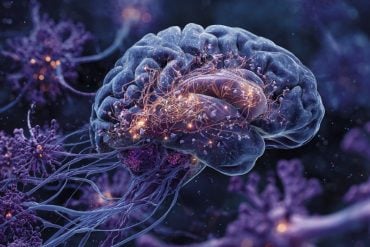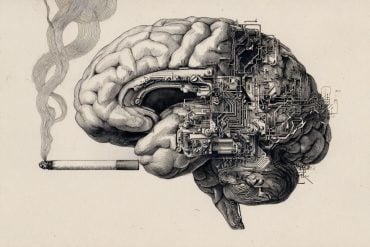Summary: Researchers have found that ketamine’s antidepressant effects target astroglia, a type of brain support cell, rather than neurons, challenging conventional views. Using zebrafish, scientists observed that ketamine suppressed the “giving up” behavior caused by futility signals, an effect linked to astroglial activation.
Whole-brain imaging revealed ketamine overstimulated astrocytes, reducing their sensitivity to stress signals and making the fish more persistent. Similar mechanisms were confirmed in mice, suggesting astroglia play a crucial role in depression treatment.
Key Facts:
- Astroglia Role: Ketamine activates astroglia, reducing their sensitivity to stress signals.
- Cross-Species Evidence: Astroglia’s response to ketamine was confirmed in both zebrafish and mice.
- New Targets: The study suggests targeting astroglia could lead to novel depression treatments.
Source: HHMI
The decades-old anesthetic ketamine could be a game changer for treating severe depression, but there are still many questions about how the drug works, including exactly how it affects the brain’s cells and circuits.
To help answer these questions, researchers are turning to an unlikely animal: tiny, days-old zebrafish.
The millimeters-long, translucent zebrafish may not get depressed exactly like humans do, but the fish do exhibit a “giving up” behavior: they stop swimming after they realize they aren’t getting anywhere – a passive behavior that scientists use to study depression in animals.

By taking advantage of this behavior, the ability to image the zebrafish’s entire brain, and a unique virtual reality system, a team of researchers from HHMI’s Janelia Research Campus, Harvard, and Johns Hopkins found where ketamine acts in the zebrafish brain: at supporting cells called astroglia, rather than neurons.
Previous research by Janelia scientists found that astroglia act as a counter that tells the fish when to give up. As the fish registers that it isn’t getting anywhere, it swims harder, and astroglia activity ramps up. When astroglia activity reaches a threshold, the cells signal to neurons for the fish to stop swimming.
The new research finds that a brief exposure to ketamine causes a lasting suppression of the “giving up” behavior by overstimulating astroglia. This overstimulation, which occurs through ketamine’s stimulation of noradrenergic neurons that activate astrocytes, appears to subsequently reduce the astroglia counter’s sensitivity, causing the fish to continue swimming normally, even when it isn’t getting anywhere.
“Our paper suggests that these astroglia, this non-neuronal cell population, are playing a very important role, and that some of the key effects of these antidepressant compounds go through changes in astroglial physiology,” says Alex Chen, a joint PhD student in the Ahrens Lab at Janelia and the Engert Lab at Harvard and a co-lead author on the paper.
The team’s findings, which also show that astrocytes are similarly activated in mice, could help researchers get a clearer picture of how antidepressants work in the brain, potentially leading to the development of safer and more effective drugs to treat depression.
Understanding how antidepressants work on a molecular level has confounded scientists for decades, with much of their work focused on the drugs’ effects on neurons.
“I think our research suggests that targeting these astrocytes to find new treatments could be an interesting way to go,” says Marc Duque Ramírez, a PhD student in the Engert Lab and a co-lead author on the paper.
Using zebrafish to test ketamine
The project started when the team, led by Duque and Chen, wanted to see if they could use zebrafish to test antidepressants that were known to work in humans and had previously been tested in rodents. Because zebrafish are small and translucent, researchers can image each animal’s entire brain to better track the drug’s effects.
The Ahrens Lab had shown in earlier work that zebrafish exhibit a trait known as futility-induced passivity, or “giving up” – a behavior that has also been seen in rodents. Using a virtual reality setup, the researchers fixed the fish in place and showed them different visual patterns.
When the fish saw a pattern simulating backward motion, they wiggled their tails as though swimming forward. When the pattern changed to one simulating being stuck in place, the animals would struggle at first, then give up, become passive, and stop swimming.
In the new work, the researchers show that ketamine suppressed this giving up behavior for over a day. Although the fish still struggled when their swimming was not effective, they did not give up as easily and were less passive.
The authors also tested other fast-acting antidepressants, such as psychedelic compounds, and found a reduction in passivity like they saw with ketamine. On the other hand, stress-inducing treatments, such as chronic glucocorticoids, increased the giving up behavior.
Imaging reveals action on astroglia
Next, the team turned their attention to what the drug was doing in the fish’s brain. Previous research by the Ahrens Lab found the giving up action is associated with a type of glial cell called radial astrocytes.
Whole-brain imaging revealed that ketamine increased the amount of calcium at the astrocytes, showing that the drug activated these cells for many minutes after administration.
The researchers think that although short or fast increases in astroglia calcium might drive giving up behavior, the aftereffects of the ketamine-induced flood of calcium reduce the astroglia’s response to the futility signal that drives giving up behavior, making the fish more robust in these behavioral situations, or less likely to give up, in the future.
“It’s desensitized because during ketamine it was so hyperactivated,” says Janelia Senior Group Leader Misha Ahrens, a senior author on the paper. “It’s like when you take a cold shower – afterwards you are a little less sensitive to the cold – but at a cellular and molecular level.”
The researchers also found that this same mechanism was at work in mammals. Eric Hsu, a graduate student at Johns Hopkins and a co-lead author on the paper, found that astrocytes were similarly activated in mice, both when they exhibit “giving up” behavior and when they are exposed to ketamine.
“This evidence of cross-species conservation increases the likelihood that comparable mechanisms exist in humans,” says Dwight Bergles, a professor of neuroscience at Johns Hopkins and a senior author on the paper.
The team’s study demonstrates that ketamine is acting on the astrocytes by increasing norepinephrine levels, though how it does that and how that changes neuronal and astroglia physiology as a result is still unknown. But the findings do point to a potential role for astroglia in depression and could help inform future research.
“We need to be careful in taking these results too literally, but this could be a model for pieces of the mammalian brain,” Ahrens says.
About this neuropharmacology research news
Author: Nanci Bompey
Source: HHMI
Contact: Nanci Bompey – HHMI
Image: The image is credited to Neuroscience News
Original Research: Open access.
“Ketamine induces plasticity in a norepinephrine-astroglial circuit to promote behavioral perseverance” by Alex Chen et al. Neuron
Abstract
Ketamine induces plasticity in a norepinephrine-astroglial circuit to promote behavioral perseverance
Transient exposure to ketamine can trigger lasting changes in behavior and mood. We found that brief ketamine exposure causes long-term suppression of futility-induced passivity in larval zebrafish, reversing the “giving-up” response that normally occurs when swimming fails to cause forward movement.
Whole-brain imaging revealed that ketamine hyperactivates the norepinephrine-astroglia circuit responsible for passivity. After ketamine washout, this circuit exhibits hyposensitivity to futility, leading to long-term increased perseverance.
Pharmacological, chemogenetic, and optogenetic manipulations show that norepinephrine and astrocytes are necessary and sufficient for ketamine’s long-term perseverance-enhancing aftereffects. In vivo calcium imaging revealed that astrocytes in adult mouse cortex are similarly activated during futility in the tail suspension test and that acute ketamine exposure also induces astrocyte hyperactivation.
The cross-species conservation of ketamine’s modulation of noradrenergic-astroglial circuits and evidence that plasticity in this pathway can alter the behavioral response to futility hold promise for identifying new strategies to treat affective disorders.







